Alsatian vs Italian Community Comparison
COMPARE
Alsatian
Italian
Social Comparison
Social Comparison
Alsatians
Italians
4,075
SOCIAL INDEX
38.3/ 100
SOCIAL RATING
206th/ 347
SOCIAL RANK
8,365
SOCIAL INDEX
81.1/ 100
SOCIAL RATING
74th/ 347
SOCIAL RANK
Italian Integration in Alsatian Communities
The statistical analysis conducted on geographies consisting of 82,644,107 people shows a significant positive correlation between the proportion of Italians within Alsatian communities in the United States with a correlation coefficient (R) of 0.619. On average, for every 1% (one percent) increase in Alsatians within a typical geography, there is an increase of 0.500% in Italians. To illustrate, in a geography comprising of 100,000 individuals, a rise of 1,000 Alsatians corresponds to an increase of 500.0 Italians.
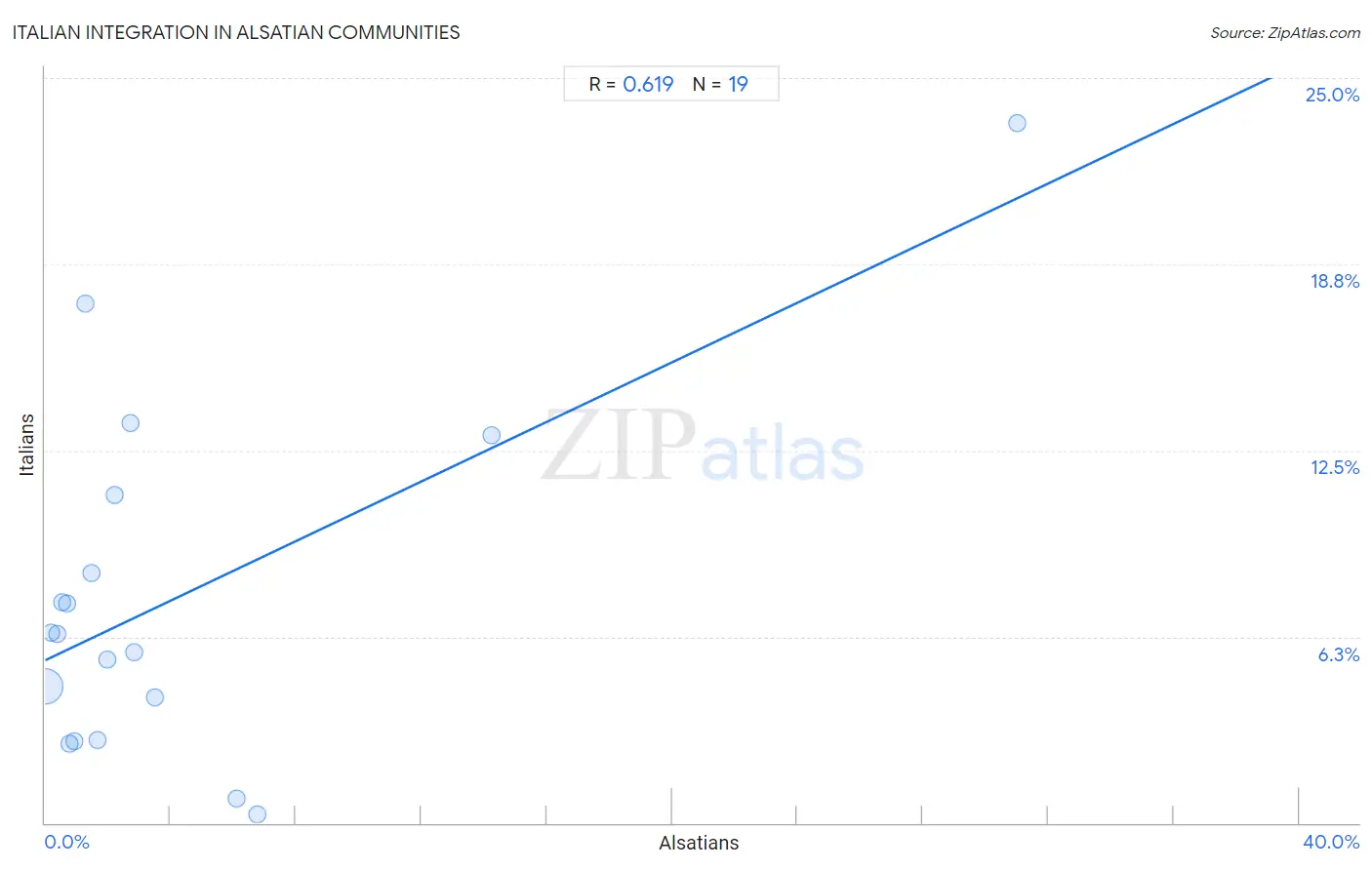
Alsatian vs Italian Income
When considering income, the most significant differences between Alsatian and Italian communities in the United States are seen in wage/income gap (24.7% compared to 28.1%, a difference of 14.0%), householder income ages 45 - 64 years ($100,435 compared to $110,224, a difference of 9.8%), and householder income ages 25 - 44 years ($95,059 compared to $104,215, a difference of 9.6%). Conversely, both communities are more comparable in terms of per capita income ($47,284 compared to $47,574, a difference of 0.61%), householder income over 65 years ($61,797 compared to $63,885, a difference of 3.4%), and median female earnings ($40,060 compared to $41,505, a difference of 3.6%).

| Income Metric | Alsatian | Italian |
| Per Capita Income | Exceptional $47,284 | Exceptional $47,574 |
| Median Family Income | Average $103,010 | Exceptional $112,372 |
| Median Household Income | Average $85,053 | Exceptional $92,475 |
| Median Earnings | Good $47,023 | Exceptional $49,915 |
| Median Male Earnings | Good $55,380 | Exceptional $59,551 |
| Median Female Earnings | Good $40,060 | Exceptional $41,505 |
| Householder Age | Under 25 years | Tragic $49,267 | Exceptional $53,426 |
| Householder Age | 25 - 44 years | Average $95,059 | Exceptional $104,215 |
| Householder Age | 45 - 64 years | Average $100,435 | Exceptional $110,224 |
| Householder Age | Over 65 years | Good $61,797 | Exceptional $63,885 |
| Wage/Income Gap | Exceptional 24.7% | Tragic 28.1% |
Alsatian vs Italian Poverty
When considering poverty, the most significant differences between Alsatian and Italian communities in the United States are seen in child poverty among boys under 16 (19.1% compared to 14.2%, a difference of 34.3%), child poverty under the age of 16 (18.6% compared to 13.9%, a difference of 34.3%), and female poverty among 18-24 year olds (24.4% compared to 18.3%, a difference of 33.1%). Conversely, both communities are more comparable in terms of single father poverty (17.8% compared to 17.5%, a difference of 1.6%), receiving food stamps (11.4% compared to 9.9%, a difference of 16.0%), and single male poverty (15.2% compared to 13.1%, a difference of 16.5%).
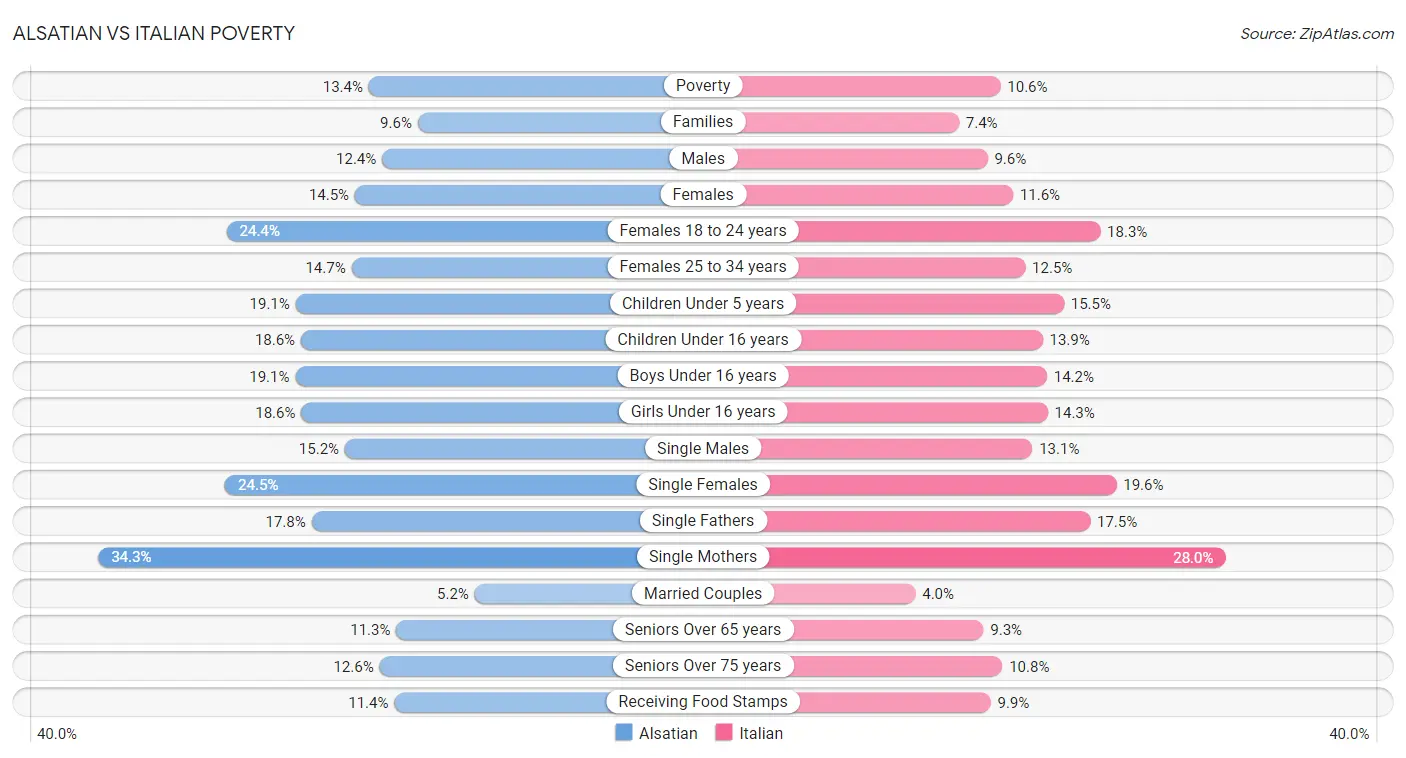
| Poverty Metric | Alsatian | Italian |
| Poverty | Tragic 13.4% | Exceptional 10.6% |
| Families | Poor 9.6% | Exceptional 7.4% |
| Males | Tragic 12.4% | Exceptional 9.6% |
| Females | Tragic 14.5% | Exceptional 11.6% |
| Females 18 to 24 years | Tragic 24.4% | Exceptional 18.3% |
| Females 25 to 34 years | Tragic 14.7% | Exceptional 12.5% |
| Children Under 5 years | Tragic 19.1% | Exceptional 15.5% |
| Children Under 16 years | Tragic 18.6% | Exceptional 13.9% |
| Boys Under 16 years | Tragic 19.1% | Exceptional 14.2% |
| Girls Under 16 years | Tragic 18.6% | Exceptional 14.3% |
| Single Males | Tragic 15.2% | Poor 13.1% |
| Single Females | Tragic 24.5% | Exceptional 19.6% |
| Single Fathers | Tragic 17.8% | Tragic 17.5% |
| Single Mothers | Tragic 34.3% | Exceptional 28.0% |
| Married Couples | Average 5.2% | Exceptional 4.0% |
| Seniors Over 65 years | Fair 11.3% | Exceptional 9.3% |
| Seniors Over 75 years | Poor 12.6% | Exceptional 10.8% |
| Receiving Food Stamps | Good 11.4% | Exceptional 9.9% |
Alsatian vs Italian Unemployment
When considering unemployment, the most significant differences between Alsatian and Italian communities in the United States are seen in unemployment among seniors over 75 years (6.1% compared to 10.0%, a difference of 63.6%), unemployment among ages 60 to 64 years (5.8% compared to 4.8%, a difference of 21.1%), and unemployment among ages 16 to 19 years (20.5% compared to 17.0%, a difference of 20.7%). Conversely, both communities are more comparable in terms of unemployment among ages 25 to 29 years (6.7% compared to 6.8%, a difference of 0.12%), unemployment among seniors over 65 years (5.2% compared to 5.2%, a difference of 0.27%), and unemployment among ages 65 to 74 years (5.5% compared to 5.5%, a difference of 0.28%).
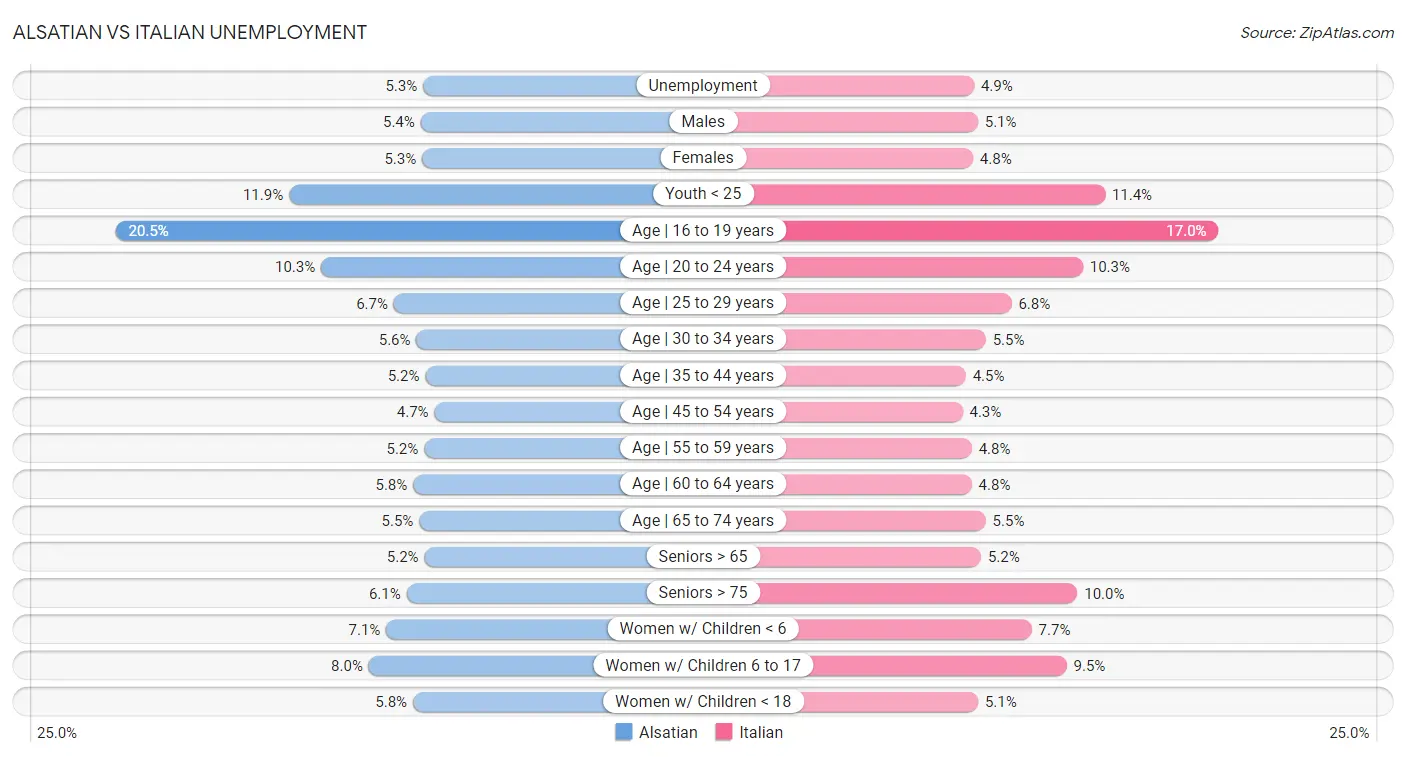
| Unemployment Metric | Alsatian | Italian |
| Unemployment | Fair 5.3% | Exceptional 4.9% |
| Males | Poor 5.4% | Exceptional 5.1% |
| Females | Fair 5.3% | Exceptional 4.8% |
| Youth < 25 | Tragic 11.9% | Excellent 11.4% |
| Age | 16 to 19 years | Tragic 20.5% | Exceptional 17.0% |
| Age | 20 to 24 years | Average 10.3% | Average 10.3% |
| Age | 25 to 29 years | Fair 6.7% | Fair 6.8% |
| Age | 30 to 34 years | Poor 5.6% | Average 5.5% |
| Age | 35 to 44 years | Tragic 5.2% | Exceptional 4.5% |
| Age | 45 to 54 years | Tragic 4.7% | Exceptional 4.3% |
| Age | 55 to 59 years | Tragic 5.2% | Good 4.8% |
| Age | 60 to 64 years | Tragic 5.8% | Excellent 4.8% |
| Age | 65 to 74 years | Tragic 5.5% | Tragic 5.5% |
| Seniors > 65 | Poor 5.2% | Tragic 5.2% |
| Seniors > 75 | Exceptional 6.1% | Tragic 10.0% |
| Women w/ Children < 6 | Exceptional 7.1% | Fair 7.7% |
| Women w/ Children 6 to 17 | Exceptional 8.0% | Tragic 9.5% |
| Women w/ Children < 18 | Tragic 5.8% | Exceptional 5.1% |
Alsatian vs Italian Labor Participation
When considering labor participation, the most significant differences between Alsatian and Italian communities in the United States are seen in in labor force | age 16-19 (35.9% compared to 40.1%, a difference of 11.7%), in labor force | age 45-54 (81.3% compared to 83.3%, a difference of 2.4%), and in labor force | age 20-24 (74.8% compared to 76.5%, a difference of 2.4%). Conversely, both communities are more comparable in terms of in labor force | age > 16 (64.7% compared to 64.6%, a difference of 0.26%), in labor force | age 30-34 (85.2% compared to 85.4%, a difference of 0.32%), and in labor force | age 35-44 (84.4% compared to 85.0%, a difference of 0.72%).

| Labor Participation Metric | Alsatian | Italian |
| In Labor Force | Age > 16 | Poor 64.7% | Tragic 64.6% |
| In Labor Force | Age 20-64 | Tragic 79.1% | Excellent 79.9% |
| In Labor Force | Age 16-19 | Poor 35.9% | Exceptional 40.1% |
| In Labor Force | Age 20-24 | Fair 74.8% | Exceptional 76.5% |
| In Labor Force | Age 25-29 | Tragic 83.9% | Exceptional 85.6% |
| In Labor Force | Age 30-34 | Exceptional 85.2% | Exceptional 85.4% |
| In Labor Force | Age 35-44 | Average 84.4% | Exceptional 85.0% |
| In Labor Force | Age 45-54 | Tragic 81.3% | Exceptional 83.3% |
Alsatian vs Italian Family Structure
When considering family structure, the most significant differences between Alsatian and Italian communities in the United States are seen in single mother households (6.2% compared to 5.6%, a difference of 10.5%), births to unmarried women (33.8% compared to 30.8%, a difference of 9.9%), and married-couple households (44.8% compared to 49.0%, a difference of 9.4%). Conversely, both communities are more comparable in terms of divorced or separated (11.9% compared to 11.9%, a difference of 0.36%), average family size (3.14 compared to 3.12, a difference of 0.67%), and single father households (2.1% compared to 2.2%, a difference of 0.79%).

| Family Structure Metric | Alsatian | Italian |
| Family Households | Tragic 61.7% | Exceptional 64.8% |
| Family Households with Children | Tragic 25.3% | Tragic 26.8% |
| Married-couple Households | Tragic 44.8% | Exceptional 49.0% |
| Average Family Size | Tragic 3.14 | Tragic 3.12 |
| Single Father Households | Exceptional 2.1% | Exceptional 2.2% |
| Single Mother Households | Good 6.2% | Exceptional 5.6% |
| Currently Married | Poor 45.7% | Exceptional 48.8% |
| Divorced or Separated | Excellent 11.9% | Good 11.9% |
| Births to Unmarried Women | Tragic 33.8% | Good 30.8% |
Alsatian vs Italian Vehicle Availability
When considering vehicle availability, the most significant differences between Alsatian and Italian communities in the United States are seen in no vehicles in household (13.2% compared to 8.6%, a difference of 52.5%), 4 or more vehicles in household (5.4% compared to 6.6%, a difference of 22.0%), and 3 or more vehicles in household (18.0% compared to 20.6%, a difference of 14.5%). Conversely, both communities are more comparable in terms of 1 or more vehicles in household (87.1% compared to 92.3%, a difference of 6.0%), 2 or more vehicles in household (52.5% compared to 58.4%, a difference of 11.3%), and 3 or more vehicles in household (18.0% compared to 20.6%, a difference of 14.5%).

| Vehicle Availability Metric | Alsatian | Italian |
| No Vehicles Available | Tragic 13.2% | Exceptional 8.6% |
| 1+ Vehicles Available | Tragic 87.1% | Exceptional 92.3% |
| 2+ Vehicles Available | Tragic 52.5% | Exceptional 58.4% |
| 3+ Vehicles Available | Tragic 18.0% | Exceptional 20.6% |
| 4+ Vehicles Available | Tragic 5.4% | Excellent 6.6% |
Alsatian vs Italian Education Level
When considering education level, the most significant differences between Alsatian and Italian communities in the United States are seen in no schooling completed (2.0% compared to 1.5%, a difference of 29.9%), doctorate degree (2.1% compared to 2.0%, a difference of 9.5%), and professional degree (5.2% compared to 4.8%, a difference of 9.3%). Conversely, both communities are more comparable in terms of college, under 1 year (67.1% compared to 67.2%, a difference of 0.060%), associate's degree (48.8% compared to 48.7%, a difference of 0.23%), and college, 1 year or more (61.3% compared to 61.1%, a difference of 0.27%).
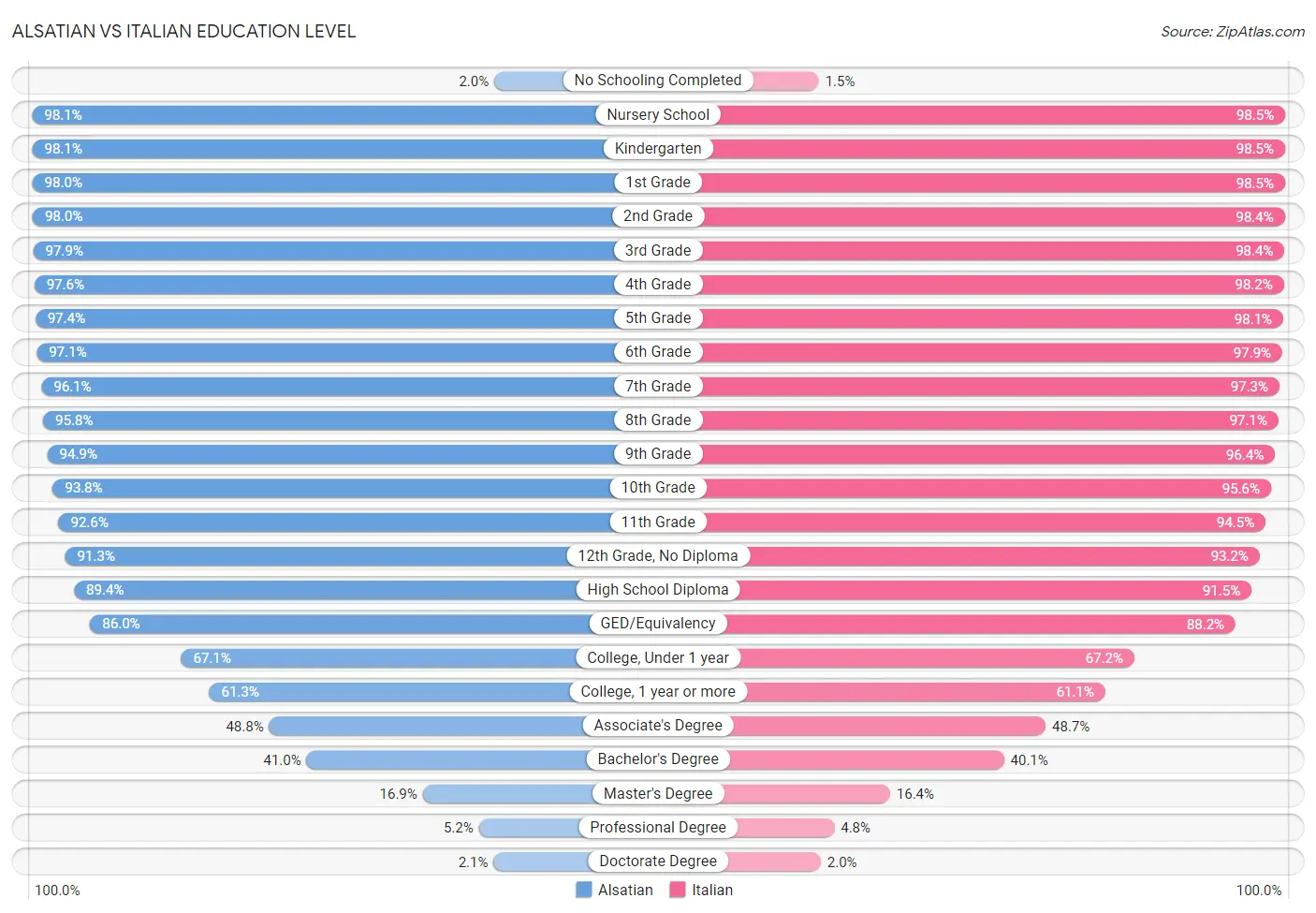
| Education Level Metric | Alsatian | Italian |
| No Schooling Completed | Good 2.0% | Exceptional 1.5% |
| Nursery School | Excellent 98.1% | Exceptional 98.5% |
| Kindergarten | Excellent 98.1% | Exceptional 98.5% |
| 1st Grade | Excellent 98.0% | Exceptional 98.5% |
| 2nd Grade | Excellent 98.0% | Exceptional 98.4% |
| 3rd Grade | Good 97.9% | Exceptional 98.4% |
| 4th Grade | Good 97.6% | Exceptional 98.2% |
| 5th Grade | Good 97.4% | Exceptional 98.1% |
| 6th Grade | Good 97.1% | Exceptional 97.9% |
| 7th Grade | Good 96.1% | Exceptional 97.3% |
| 8th Grade | Good 95.8% | Exceptional 97.1% |
| 9th Grade | Average 94.9% | Exceptional 96.4% |
| 10th Grade | Average 93.8% | Exceptional 95.6% |
| 11th Grade | Good 92.6% | Exceptional 94.5% |
| 12th Grade, No Diploma | Average 91.3% | Exceptional 93.2% |
| High School Diploma | Good 89.4% | Exceptional 91.5% |
| GED/Equivalency | Good 86.0% | Exceptional 88.2% |
| College, Under 1 year | Exceptional 67.1% | Exceptional 67.2% |
| College, 1 year or more | Exceptional 61.3% | Excellent 61.1% |
| Associate's Degree | Exceptional 48.8% | Exceptional 48.7% |
| Bachelor's Degree | Exceptional 41.0% | Exceptional 40.1% |
| Master's Degree | Exceptional 16.9% | Exceptional 16.4% |
| Professional Degree | Exceptional 5.2% | Exceptional 4.8% |
| Doctorate Degree | Exceptional 2.1% | Excellent 2.0% |
Alsatian vs Italian Disability
When considering disability, the most significant differences between Alsatian and Italian communities in the United States are seen in disability age under 5 (1.2% compared to 1.6%, a difference of 29.2%), vision disability (2.3% compared to 2.1%, a difference of 10.5%), and hearing disability (3.1% compared to 3.4%, a difference of 8.5%). Conversely, both communities are more comparable in terms of disability (12.1% compared to 12.2%, a difference of 0.28%), ambulatory disability (6.3% compared to 6.2%, a difference of 0.65%), and disability age 18 to 34 (7.0% compared to 7.1%, a difference of 0.96%).
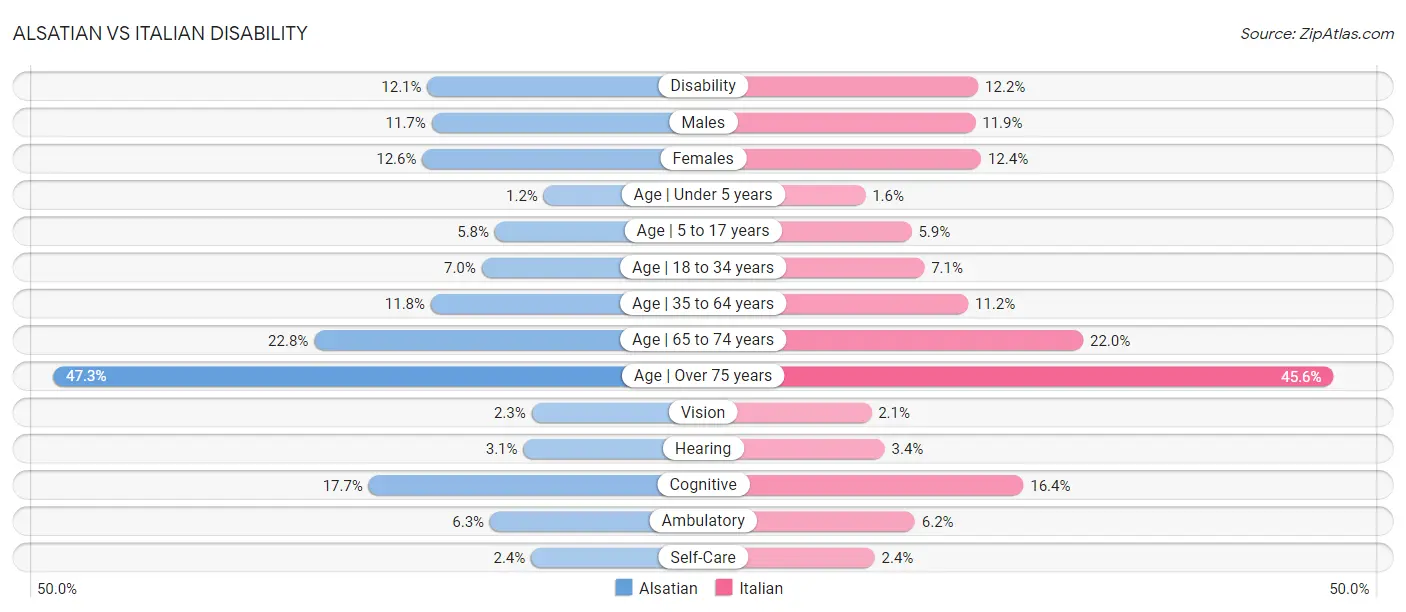
| Disability Metric | Alsatian | Italian |
| Disability | Tragic 12.1% | Tragic 12.2% |
| Males | Tragic 11.7% | Tragic 11.9% |
| Females | Tragic 12.6% | Poor 12.4% |
| Age | Under 5 years | Good 1.2% | Tragic 1.6% |
| Age | 5 to 17 years | Tragic 5.8% | Tragic 5.9% |
| Age | 18 to 34 years | Tragic 7.0% | Tragic 7.1% |
| Age | 35 to 64 years | Tragic 11.8% | Average 11.2% |
| Age | 65 to 74 years | Excellent 22.8% | Exceptional 22.0% |
| Age | Over 75 years | Average 47.3% | Exceptional 45.6% |
| Vision | Tragic 2.3% | Good 2.1% |
| Hearing | Poor 3.1% | Tragic 3.4% |
| Cognitive | Tragic 17.7% | Exceptional 16.4% |
| Ambulatory | Poor 6.3% | Fair 6.2% |
| Self-Care | Exceptional 2.4% | Good 2.4% |